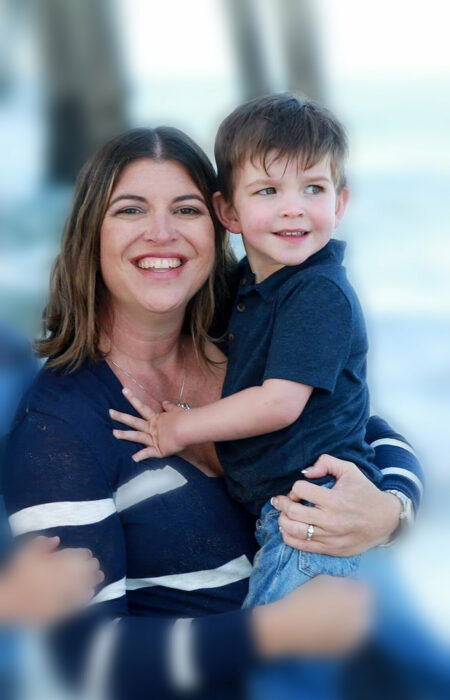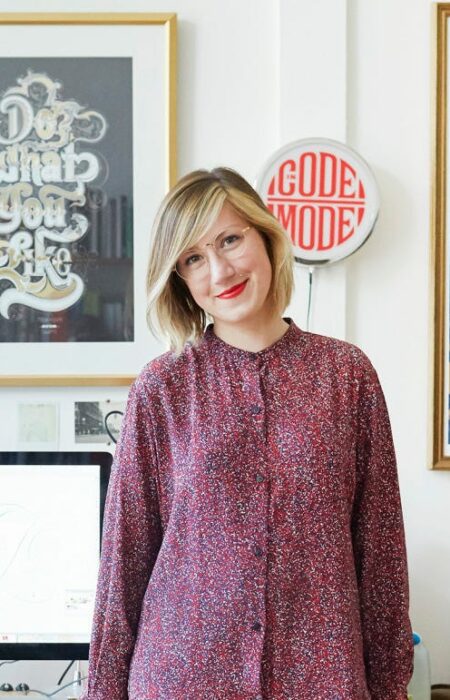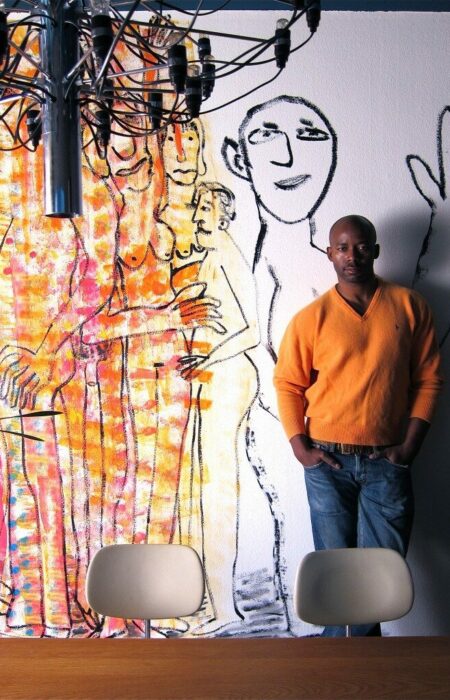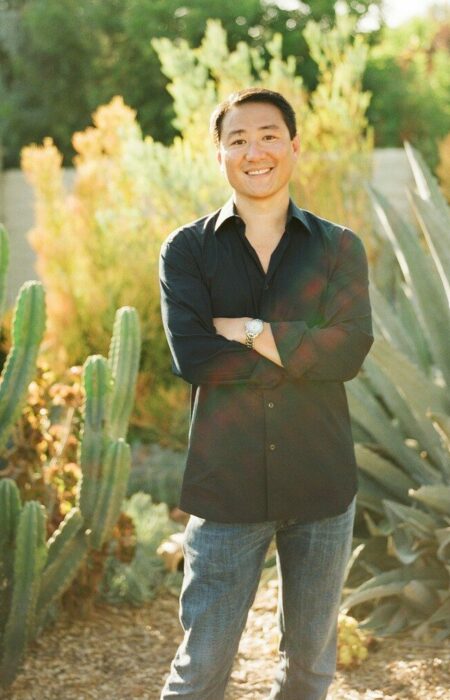Ron van Dongen‘s photographs of flowers are so beautiful they could make your knees buckle. Born in Venezuela and raised in Holland, Ron imbues his images with the vibrant sensuality of one culture and the quiet restraint of the other. Now residing in Portland, Oregon, he grows his photographic subjects in his own garden, then captures their beauty using a large format view camera. Already a very accomplished black and white photographer, Ron’s career really took off when he started shooting in color and playing with the same limited tonal values. Now with several books to his credit and loyal galleries representing him all over the world, Ron has achieved success beyond what he could have imagined.
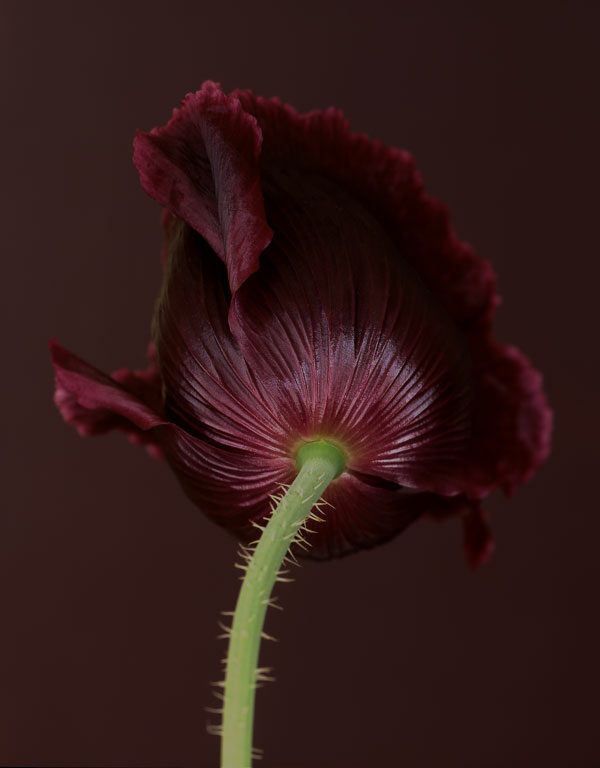
Papaver ‘Black Cloud’ by Ron van Dongen
I see you studied photography at the Academy of Art College in San Francisco. Were you an artistic child, and how did you initially venture into the world of photography?
I don’t see myself as growing up as an artistic child. It was definitely clear to me that the conventional way of studying and getting a diploma and getting a job was not going to be my life’s course — however, I had no idea what I else I would do. I did get my diploma but along the way I discovered that intellect and science and studying were not my forte, and I was discovering that the visual aspect of life was really important to me, not realizing it at the time. But looking back, I definitely see a lot of signs now that directed me to a career in visual arts.
What I mostly did growing up besides studying was gardening a lot. That’s how my interest in plants started. I had a little plot in my backyard that I was able to use to grow plants, vegetables, annuals, and that’s how my interest in nature started. I must have been 6 with my little tiny greenhouse with annuals and just looking everyday, waking up to see if they had germinated yet. And those were my very first memories of being interactive with nature.
I did the normal course of things — I went through high school and college and started traveling in 1983 and went to Chicago by myself and stayed with relatives. I went to a little private college in Chicago, and that’s where I ended up taking a liberal arts class. That in itself was a novelty to me, to have to take a liberal arts class in order to proceed with my studies! I had started taking pictures during my travels, but just as a hobby. I saw a black and white photography class listed as one of the liberal arts classes, and I took that. That was really a defining moment where I discovered ‘wow, this is really interesting, and there’s much more to it than I had ever imagined it to be’ — and I took it very seriously. I had a teacher who was also very motivated and very inspiring to me, and I continued doing photography even after my travels took me back to Holland and where I continued my studies in college to get my degree in biology and public health. I realized that after I was done with college, I probably would not find a job in my discipline but rather focus on photography.
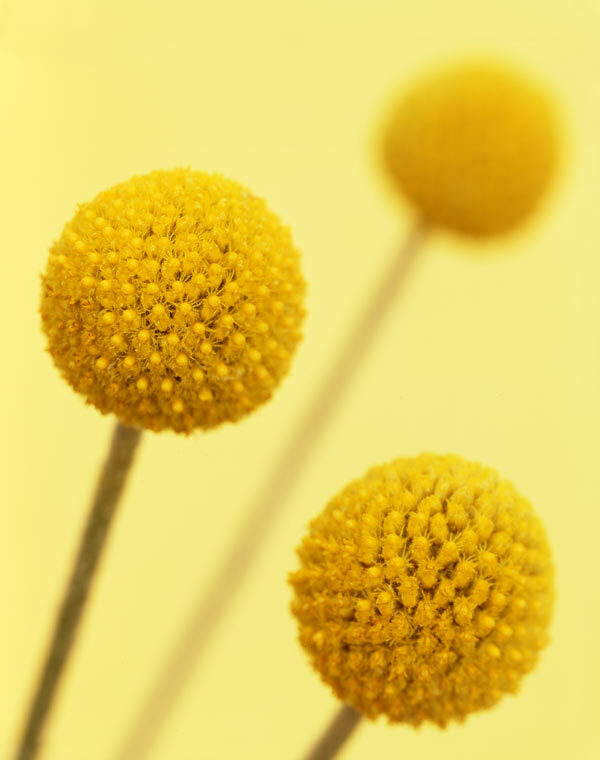
Craspedia globosa, by Ron van Dongen
I understand you primarily did black and white photography until a friend suggested you shoot in color. This color work is especially stunning, and since you seem to be quite prolific in this area, there must be something about it that really engages you.
Yes, basically going from black and white to color — I don’t know what the analogy would be — I find myself standing in a candy store! I had done black and white for so long, and I think black and white has a quality of seriousness, just something that is more official and respected … at the time. I will say now there’s clearly a shift in sort of black and white to color photography in the art world as well. But at the time I finally experimented with color photography, I found myself really loosening up and feeling like a kid in a candy store.
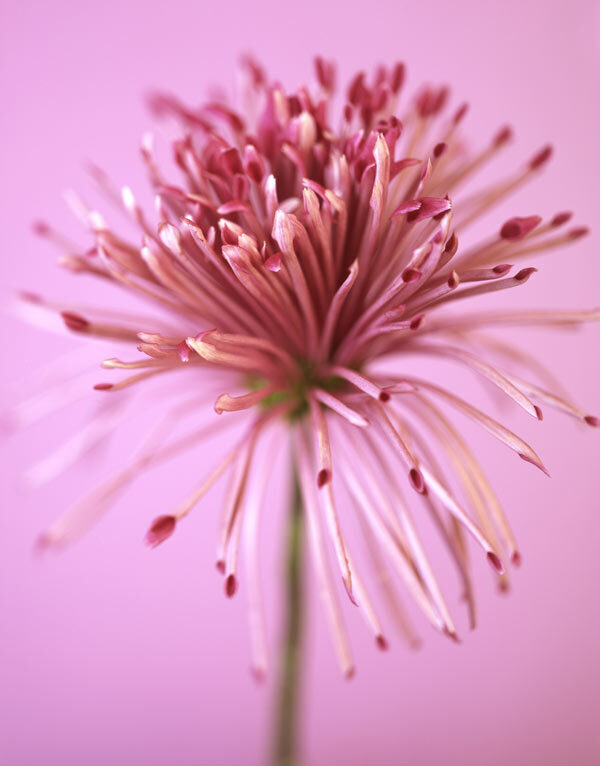
Chrysanthemum ‘Carrousel’ by Ron van Dongen
With your color photography, what are you most trying to capture on film?
The color work really was a continuation of the black and white work where I had discovered different fields of focus, where I first was more interested in the opulence and the texture and the drama of black and white photography. There were a lot of references to old Dutch painters — Rembrandt, Vermeer, Jan Steen, a lot of Golden Age painters that used light so beautifully and so dramatically — that’s what I tried to emulate with my very first set of still lifes. And unconciously, but naturally, I diverted from that to go more toward graphic, monotonal imagery where there was almost a lack of directional lighting, where I was more interested in simpler forms, fewer tonal values, and where I started to really exercise creating images that were black on black, or white on white, or gray on gray. I really tried to get very good at that, and this was really my focus in the latter part of my black and white studies. When I finally started to do color work, I really tried to continue that work with fewer tonal values. Now I realize I can do it endlessly with any color I like — green on green, purple on purple, anything I like.
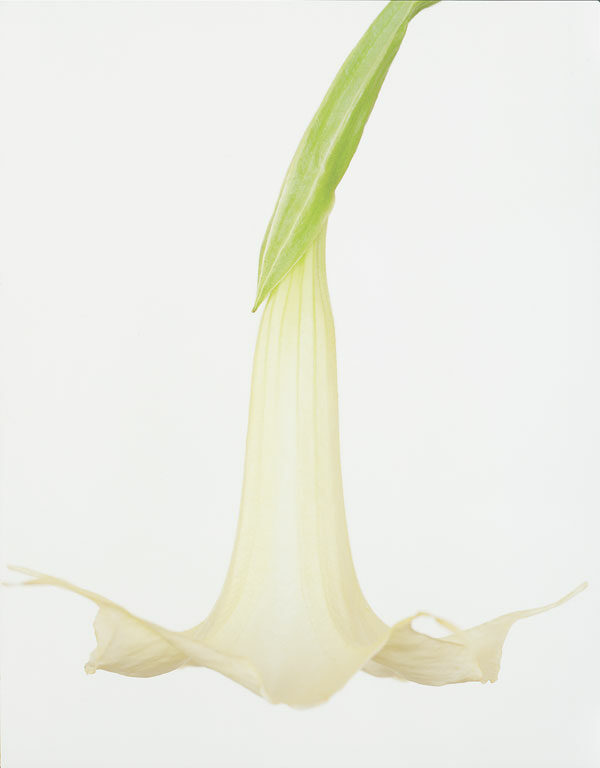
Brugmansia ‘Candida’ by Ron van Dongen
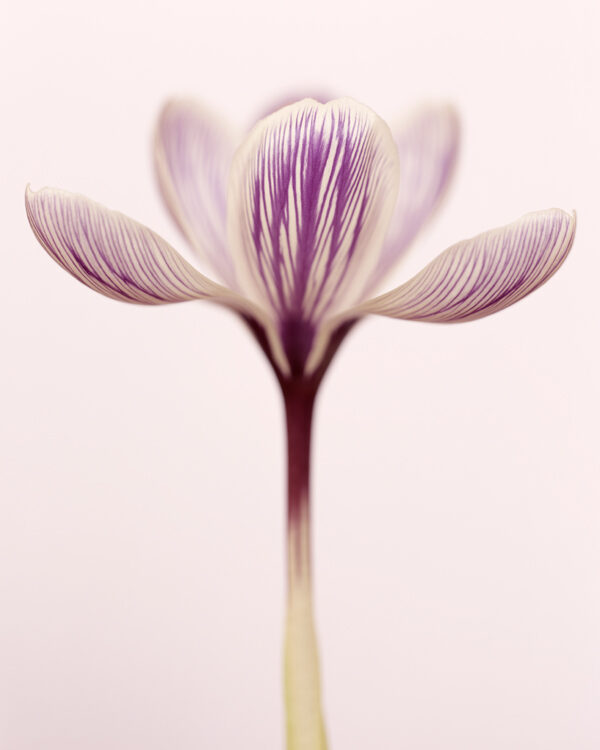
Crocus ‘Pickwick’ by Ron van Dongen
One of the hallmarks of your botanical photography — what I think really sets you apart from other photographers doing macro shots of flowers — is that the images are sensual but not crass or vulgar. You seem to have a deep respect and a fondness for your subjects. Even the use of their Latin names shows a certain respect.
I don’t really look at other photographers. Of course, we all know Karl Blossfeldt and Robert Mapplethorpe, the classics, but I have not studied their work consciously or deliberately. I really feel that my main focus is the fact that I have a different relationship with the plants because I’ve literally grown up with them. Not to say that I am a botanist or landscape architect, and my scientific knowledge of the plant world is limited. But just my everyday experience with the plants is very extensive, and I think the images are a result of that experience.

Nelumbo nucifera ‘Wanshou Hing’ by Ron van Dongen
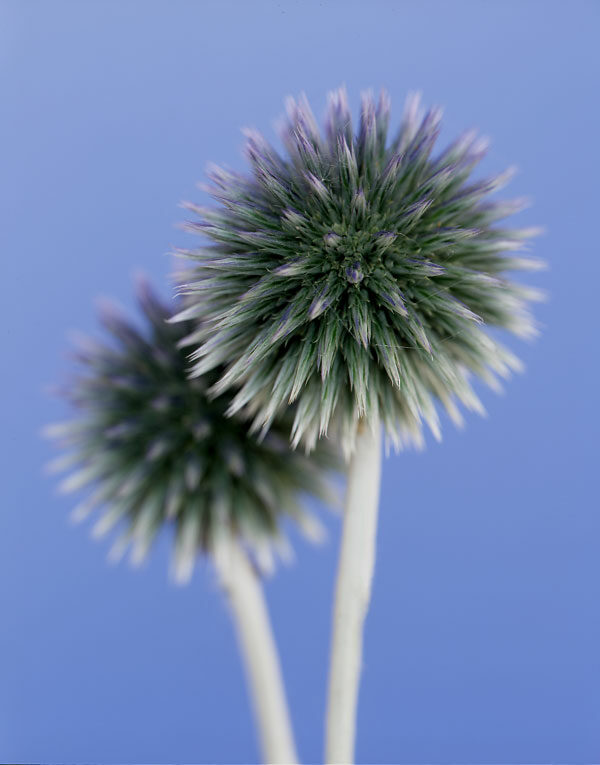
Echinops ritro by Ron van Dongen
Do you think being born in Venezuela and raised in Holland had any influence on your relationship with nature, art, or beauty?
I think Venezuela for sure. If I look back, I was born there and lived there until I was only 6. But my visual memories are so strong — I can describe the backyard we had there, or the streets and trees. I can clearly remember stealing lemons out of the neighbor’s yard — or “borrowing” rather!
In Holland, a lot of my free time was spent on the water, in the woods, in creeks, in tulips fields. My parents’ house was right in the middle of the famous tulip agricultural area in Holland. When I go home, I usually go when the tulip season is. I take advantage of the area and the connections I have with the growers, and I can have access to varieties that are usually hard to find. I know the industry, I know the seasons, I feel the seasons. As a kid, I used to work in the fields, harvest the bulbs and divide them, and do all that kind of stuff for money for vacations. So it’s a part of your existence, whether you like it or not!
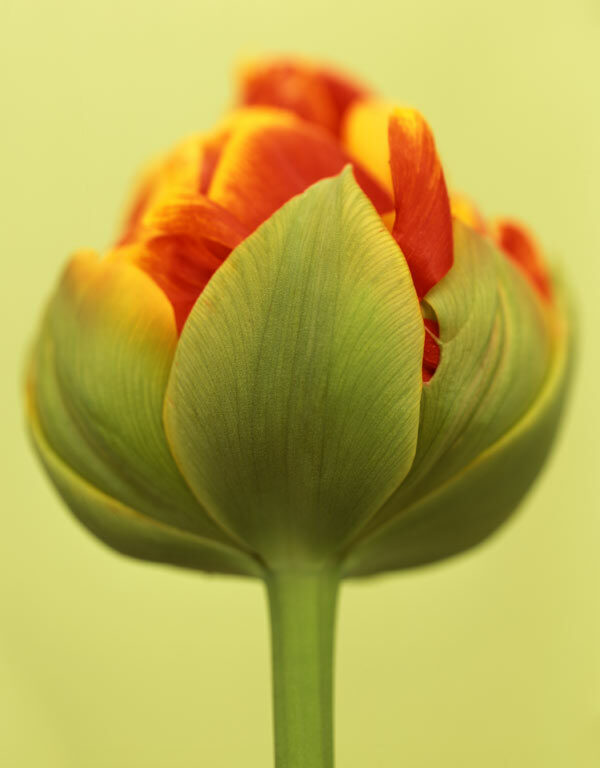
Tulipa cilesta by Ron van Dongen
I’m told you grow these flowers in your garden and then cut them to photograph them indoors. They seem so alive and full of personality, so are you in a race against time to capture that beauty?
Yes, depending on the variety of plant! Some plants I can keep inside for days and they actually mature a little bit more and get to a place of rest or repose, and other plants I have to really act quickly and photograph them literally within minutes after I cut them. And you learn that over time — in the beginning it was just trial and error. But now I can tell which ones I can take my time with and adjust leisurely, and other plants I have to make sure everything is in perfect condition, lighting is good, and then try to work as fast as I can.
I love that you’re not afraid to photograph these flowers with a painted background of a similar color for a tone-on-tone effect. How much thought are you putting into the choice of color background and the staging of the shot?
It’s a little different now because I can predict a little better what it’s going to look like, but in the beginning it took me a long time of just looking and looking again at the plants outside and seeing ‘ok, what would work well with this?’ I have this really thick paint chip book, so I’d go outside and look at all the paint chips to see what goes best with the color of the leaves or the color of the flower or what color in the flower I want to repeat in the backdrop, and then I try to match it with the paint chips. When I make a decision, I go to the paint store and get a small amount of that paint and paint the backdrop first and let it dry and then I cut the flower if I know I need to work fast — or I cut the flower first, bring it inside and then study the color and paint the backdrop if the plant allows me to take that time.
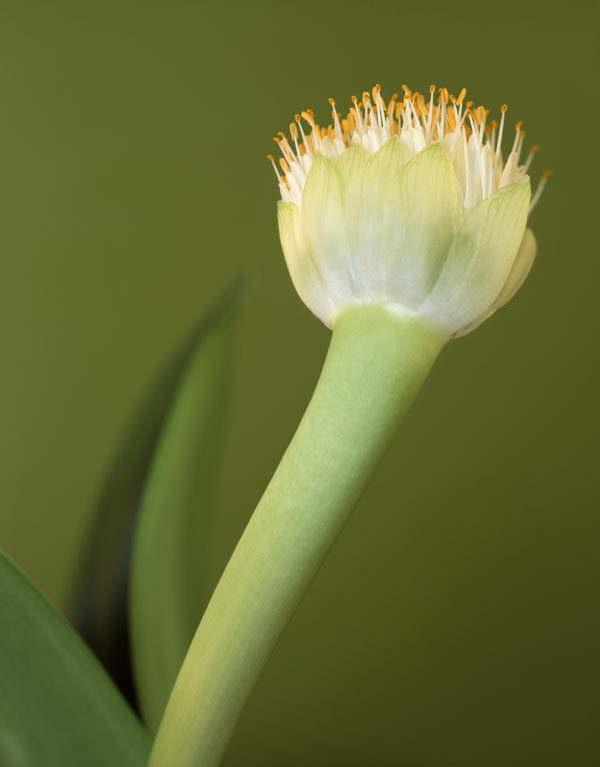
Haemanthus albiflos by Ron van Dongen
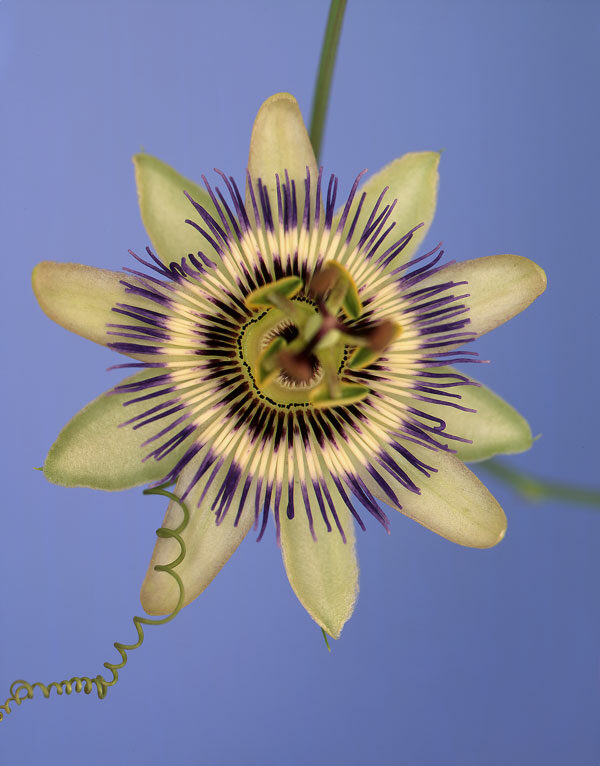
Passiflora ‘Blue Crown’ by Ron van Dongen
And you’re using both natural light through a window and studio lights?
No, it’s done in a studio, but it’s all natural light using north and east facing windows. I use a diffuser, and sometimes I use little pieces of cardboard to eliminate pieces of light, or move my table to adjust the angle of the light. And I have blinds on the windows to actually regulate the amount of light coming into the room.
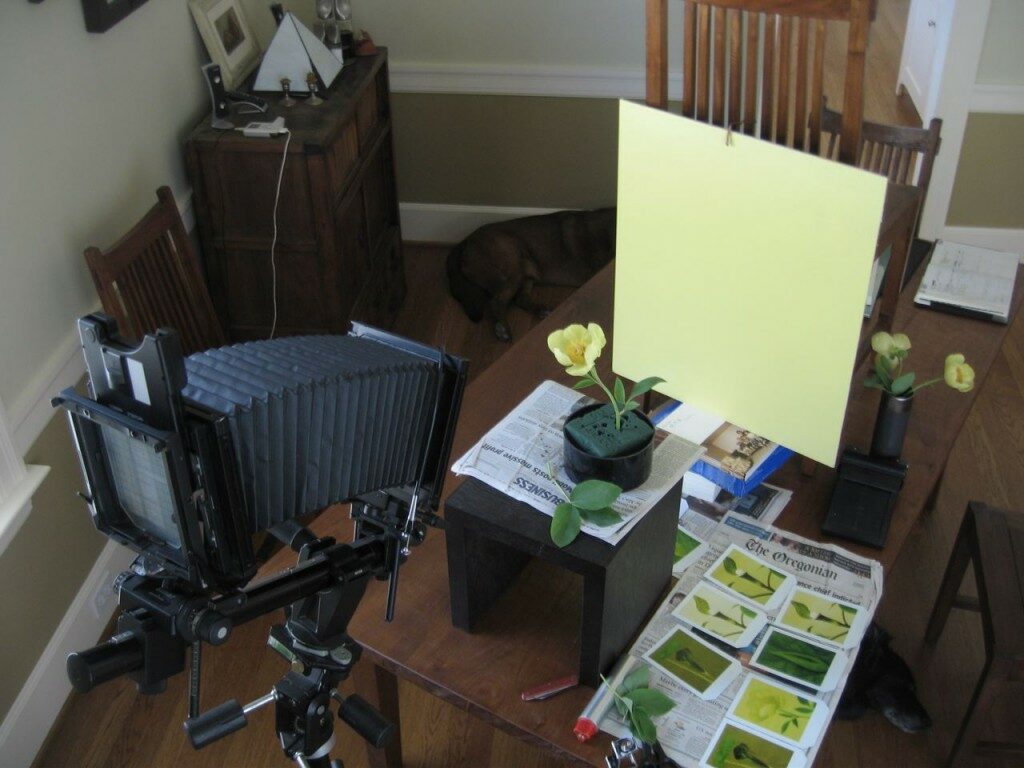
Ron’s studio in his home
I know you work exclusively with a large format view camera (a Sinar F1). Do you envision a time when digital photography will allow someone to capture the same high resolution and provide the same degree of control?
I hope so! I’d be all for a digital back to a large format view camera, but they’re very expensive. Right now, I’m still using film. With black and white work I still print on photographic paper, and for color work I print as a pigment print on a watercolor paper to emulate the effects that I get with black and white. That’s what I’m doing now — but I don’t know, in a month, in a year, if they decide to stop making film or stop processing, I don’t know what I’m going to do!
Do you know right away when you’ve taken an outstanding photograph?
No, not at all. I think I do, and then when I get my film back from the lab, it’s almost always disappointing! And then the other way around — shots that I take really quickly or don’t even think about, I get them back and think ‘wow, that really looks much nicer than I thought!’
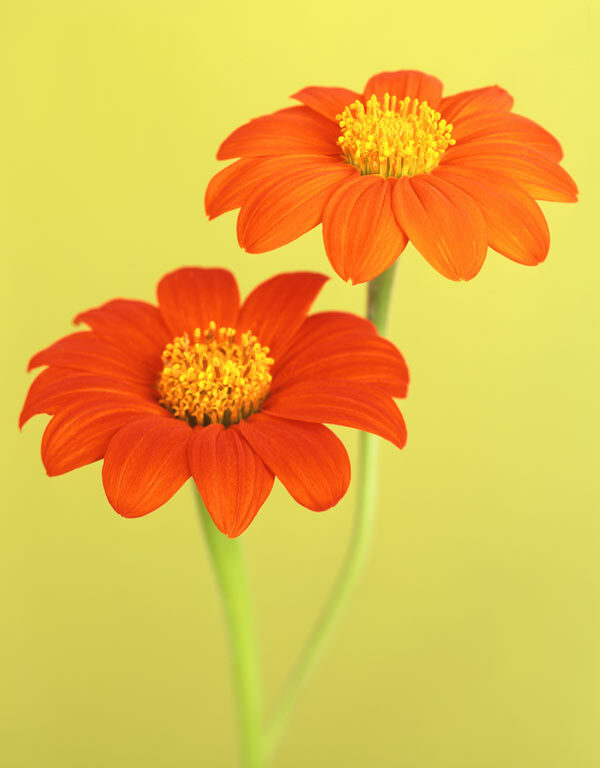
Tithonia rotundiflora ‘Torch’ by Ron van Dongen
I’m wondering what you consider some of your proudest achievements and whom you count as admirers or customers of yours?
I feel proud of the fact that I’ve been able to have this consistent career. I have never been someone who’s hoped for big highlights or star appeal or fame or anything like that. I like a quiet existence, and I’m extremely fortunate that I’ve been able to do this 100%. I have very loyal customers, clients, and galleries — and that’s all I can hope for. I have no big name I can put on my resume, maybe other than one of my biggest clients is Ralph Lauren — they’ve been very supportive and loyal to me. They buy the original work, which I think is pretty unusual.
What are some of your favorite things, whether they directly impact your work or just make you happy?
Animals — I spend a lot of time with my dog. I’ve trained him as a therapy animal. So we do volunteer work in hospitals, and that’s very important to me and gratifying. Other than that, I’m outside a lot.
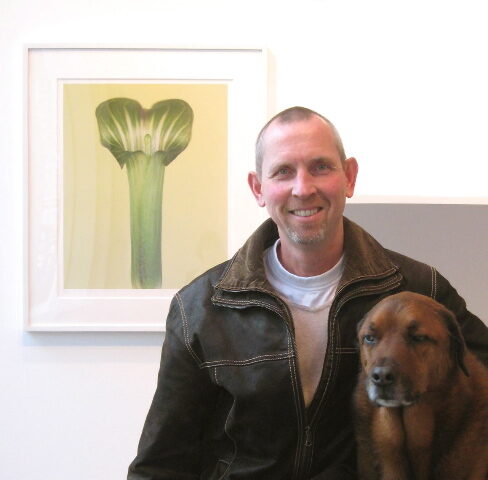
Ron with his dog Riley



